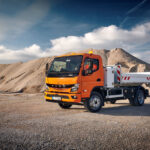Green crusaders?
Green crusaders?
Frans Timmermans, executive vice president of the European Commission for the European Green Deal, highlights the fact that heavy-duty vehicles are responsible for more than a quarter of greenhouse gas (GhG) emissions from road transport. Nevertheless, JACO DE KLERK discovers that extra-heavy commercial vehicles could play an important role as green crusaders.
During his opening remarks at a press conference on the revision of CO2 standards for heavy-duty vehicles, Timmermans pointed out that 99% of trucks and buses currently on the EU’s roads run on diesel internal combustion engines. “It makes them heavily dependent on imported fossil fuels and it also contributes to air pollution. Still, over 300 000 Europeans every year die prematurely because of air pollution,” he stated.
He added that the objective is pretty straightforward: “All trucks and buses will have to head for a zero-emission future. It will be a gradual shift. By 2030, we require that they emit 45% less compared to 2019. In 2035 this will have to be 65% less and in 2040 it will be 90% less than in 2019.”
As with the legislation on cars and vans, Timmermans said this only concerns new trucks and buses coming to the market. “This means that fleets will gradually get cleaner as the vehicles are renewed by their operators,” he explained.
He added that the targets are fleet based, so operators must meet them as an average over their entire fleet. “So, 90% by 2040 means that the vast majority of new trucks and long-distance buses coming on the market will be zero emissions – powered by batteries, fuel cells, or even hydrogen-powered internal combustion engines,” he elaborated.
Many original equipment manufacturers are ahead of the curve, however, with Volvo Trucks being a stellar example. The company is testing hydrogen-powered electric trucks, which only emit water vapour, on public roads. This is not being done on just any public road, though. To make it extra challenging, the tests are being conducted in the frigid climate of the Arctic Circle in the north of Sweden.
“Trucks are operating seven days a week and in all types of weather. The harsh conditions on public roads in northern Sweden – with ice, wind, and lots of snow – make an ideal testing environment,” says Helena Alsiö, VP of powertrain product management at Volvo Trucks. “I am pleased to say that the tests are going well, confirming tests we carried out beforehand both digitally and on our confined test track close to Gothenburg.”
Volvo Trucks showcased its fuel cell electric trucks for the first time last year. These zero-exhaust-emission trucks use hydrogen to produce their own electricity on board. This makes them suitable for longer transport assignments, or when using only batteries isn’t an option (for example, in rural areas with no charging infrastructure).
The fuel cell electric trucks will be available in the second half of this decade, and tests with hauliers will start a few years before the commercial launch. To speed up the development, Volvo Group has joined forces with Daimler to develop and produce fuel cell systems that are tailor-made for heavy-duty vehicles.
“We need to act now in order to stop global warming,” says Roger Alm, president of Volvo Trucks. “Regardless of the transport assignments or where in the world our customers are operating, waiting is not an option. In a few years, our customers will be able to completely eliminate CO2 exhaust emissions from their trucks.”
For hauliers who want to offer zero-exhaust-emission transport right now, Volvo Trucks currently offers six different battery-electric models, as well as trucks that run on renewable fuels such as biogas.
The Volvo FM extra-heavy electric derivative has also made it to South Africa. Leading auto logistics provider KDG Logistics, for example, has purchased a Volvo electric truck (with another one on order) for its local operations in Durban.
Volvo Trucks South Africa has also tested a FM 4×2 truck tractor on a local route. Eric Parry, Volvo Trucks South Africa’s sustainable solutions manager, put the vehicle through its paces on a trip from the company’s dealer in Durban to its facilities in Johannesburg – a 600km journey – with only one stop for charging.
“We aimed to prove that an extra-heavy electric truck like this can drive long distances. Even though we didn’t carry any payload, it still gave us a good indication of just what this truck is capable of,” says Parry. “Generally, battery-electric trucks are used in regional distribution – operating in and around cities, running from distribution centres to stores – but with proper planning, customers will be able to do so much more.”
Volvo Trucks South Africa is bringing in its complete extra-heavy electric truck range, which includes the FH, FM, and FMX models in truck-tractor and rigid configurations. Axle combinations will also include 4×2 through to 8×4 models. The full load on the first FM units will be 44 tonnes gross combination mass (GCM), with 490 kW of power and 2 400 Nm of torque.
“Locally, there has been a lot of activity and interest around electromobility – a lot quicker than we anticipated – and the enthusiasm and opportunities in South Africa are there,” notes Sally Rutter, Volvo Trucks South Africa’s sales director.
“Irrespective of local challenges when it comes to loadshedding and infrastructure, a lot of customers are looking at setting up their own charging infrastructures to accommodate electromobility and their own sustainability goals,” she adds.
“These trucks can run meaningful kilometres in a day and if you have your charging set-up optimised, you can extend that range quite comfortably and match your operations to it,” Parry asserts. “Within regional operations, public charging is not really relevant for these types of fleets; having control of their own charging will allow customers to fix their costs of energy. These electric trucks will be working commercial vehicles, and are designed to be treated and driven as such. We are excited about Volvo Trucks’ electromobility future in South Africa.”
So, while extra-heavy commercial vehicles are currently responsible for a considerable amount of air pollution, forward-thinking industry players are setting this segment up to be a green crusader as the world moves towards a more sustainable future.
Published by
Jaco de Klerk
focusmagsa




